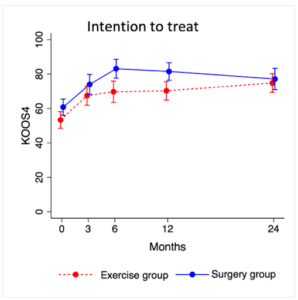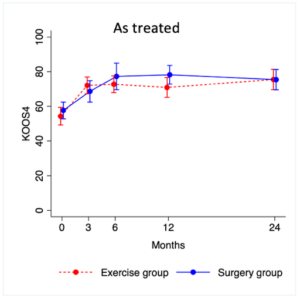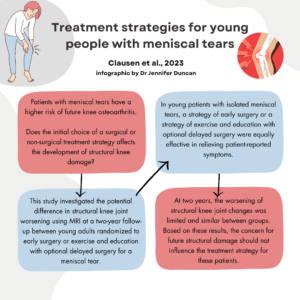Keywords: Knee, meniscal tear, structural damage
This blog is based on a recent study exploring differences in structural knee joint damage [1].
Why is this study important?
Recently, two randomized trials compared a strategy of early meniscal surgery to a strategy of exercise therapy with the option of later surgery (if needed) in young active patients with meniscal tears. Both studies reported clinically relevant improvements in pain and function for both strategies but with no difference in outcomes between treatments [2, 3].
However, since patients with meniscal tears have a higher risk of future knee osteoarthritis, an important question is whether the initial choice of a surgical or non-surgical treatment strategy affects the development of structural knee damage [4]. Theoretically, exercise therapy could cause further damage to an already injured knee joint. Still, on the other hand, arthroscopic partial meniscectomy has been reported to be associated with an increased risk of structural worsening in middle-aged and older patients with degenerative meniscal tears [5, 6].
In this study, we investigated the potential difference in structural knee joint worsening assessed by MRI at a two-year follow-up between young adults randomized to early surgery or exercise and education with optional delayed surgery for a meniscal tear. Moreover, we investigated potential differences in patient-reported outcomes.
How did the study go about this?
We used data from the ‘Danish RCT on Exercise vs Arthroscopic Meniscal Surgery for Young Adults (DREAM) trial’– a multi-centre RCT [2]. Participants were 18-40 years of age, had a clinical history and symptoms consistent with a meniscal tear (confirmed on MRI) and were deemed eligible for meniscal surgery. Most patients had a traumatic symptom onset, but the inclusion was not limited to a specific type of symptom onset, duration, or tears. Patients randomly assigned to surgery underwent arthroscopic partial meniscectomy or meniscal repair at the discretion of the surgeon. Patients allocated to exercise therapy participated in a 12-week program consisting of twice-weekly supervised exercise sessions delivered by trained physical therapists with the option of later surgery if needed.
We assessed the worsening of structural knee joint damage on MRI, focusing on cartilage and bone [7]. To determine the effect of the two treatment strategies, we compared the change in the mean score of four Knee Injury and Osteoarthritis Outcome Score (KOOS4) sub scales covering pain, symptoms, function in sport and recreation, and quality of life from baseline to two years [8].
What did the study find?
In total, 82/121 patients (68%) completed the two-year follow-up (equally distributed among treatment groups). We found that the two-year worsening of structural knee damage on MRI was low and similar in patients undergoing early surgery or exercise with optional delayed surgery (7 patients had progressed cartilage damage, and osteophytes developed in 2 (2.6%) patients). Similar to the 12-month results, early surgery was not superior to a strategy of exercise and education with optional delayed surgery in improving pain, function, and quality of life at two years [5]. At 12 months, 26% of patients in the exercise group had delayed surgery. Between 12 months and two years, two patients in the exercise group had surgery, while four in the surgical group had a second surgery.


Legend: The Graphs illustrate the outcome (KOOS 4 ) in the two treatment groups. Patients are distributed according to treatment group (intention to treat) or with all patients undergoing surgery included in the surgical group (as treated). The error bars indicate 95% CIs.
What are the key take-home points?
In young patients with isolated meniscal tears, a strategy of early surgery or a strategy of exercise and education with optional delayed surgery were equally effective in relieving patient-reported symptoms. At two years, the worsening of structural knee joint changes was limited and did not seem to depend on the treatment strategy. Further long-term studies are needed to confirm these results. Based on our results, the concern for future structural damage should not influence the choice of treatment strategy for young patients with meniscal tears.

Authors:
Stine Clausen1, PhD, Søren T. Skou1,2, PhD, Mikael Boesen3, PhD, Per Hölmich4, DMSc, Martin Lind5, PhD, Jonas B. Thorlund1,6, PhD for the DREAM Study Group.
Corresponding author:
Stine Clausen, Department of Sports Science and Clinical Biomechanics, University of Southern Denmark, Campusvej55, 5230 Odense M, Denmark.
Telephone 0045 3025 6613
Email: sclausen@health.sdu.dk
The authors would like to acknowledge the rest of the author group for their contribution to the study:
Dimitar Radev3, MD, Engin Yeter Kurt3, MD, Camma Damsted1,2, PhD, Sofus Tørring7, MD, Christin Isaksen8, MD, Claus Varnum9, PhD, Martin Englund10, PhD
1 Center for Muscle and Joint Health, Department of Sports Science and Clinical Biomechanics, University of Southern Denmark, Odense, Denmark.
2 The Research Unit PROgrez, Department of Physiotherapy and Occupational Therapy, Næstved-Slagelse-Ringsted Hospitals, Denmark, Region Zealand, Slagelse, Denmark.
3 Department of Radiology, Copenhagen University hospital Bispebjerg and Frederiksberg, Denmark
4 Sports Orthopedic Research Center – Copenhagen (SORC-C), Department of Orthopaedic Surgery, Copenhagen University Hospital, Amager-Hvidovre, Copenhagen, Denmark
5 Department of Orthopedics, Aarhus University Hospital, Aarhus, Denmark
6 Research Unit for General Practice, Department of Public Health, University of Southern Denmark, Odense, Denmark.
7 Department of Radiology, Aalborg University Hospital, Aalborg, Denmark
8 Department of Radiology,Diagnostic Centre, University Research Clinic for Innovative Patient Pathways, Silkeborg Regional Hospital, Silkeborg, Denmark.
9 Department of Orthopaedic Surgery, Lillebælt Hospital – Vejle, Denmark
10 Clinical Epidemiology Unit, Orthopedics, Department of Clinical Sciences Lund, Lund University, Lund, Sweden
References:
- Clausen SH, Skou ST, Boesen MP, et al Two-year MRI-defined structural damage and patient-reported outcomes following surgery or exercise for meniscal tears in young adults British Journal of Sports Medicine 2023;57:1566-1572.
- Skou ST, Hölmich P, Lind M et al. Early Surgery or Exercise and Education for Meniscal Tears in Young Adults. NEJM Evidence 2022; 1: EVIDoa2100038. DOI: doi:10.1056/EVIDoa2100038
- van der Graaff SJA, Eijgenraam SM, Meuffels DE et al. Arthroscopic partial meniscectomy versus physical therapy for traumatic meniscal tears in a young study population: a randomised controlled trial. Br J Sports Med 2022; 56: 870-876. DOI: 10.1136/bjsports-2021-105059
- Poulsen E, Goncalves GH, Bricca A et al. Knee osteoarthritis risk is increased 4-6 fold after knee injury – a systematic review and meta-analysis. Br J Sports Med 2019; 53: 1454-1463. DOI: 10.1136/bjsports-2018-100022
- Collins JE, Shrestha S, Losina E et al. Five-Year Structural Changes in Patients with Meniscal Tear and Osteoarthritis: Data from an RCT of Arthroscopic Partial Meniscectomy vs. Physical Therapy. Arthritis Rheumatol 2022. DOI: 10.1002/art.42105
- Roemer FW, Kwoh CK, Hannon MJ et al. Partial meniscectomy is associated with increased risk of incident radiographic osteoarthritis and worsening cartilage damage in the following year. Eur Radiol 2017; 27: 404-413. DOI: 10.1007/s00330-016-4361-z
- Roemer FW, Frobell R, Lohmander LS et al. Anterior Cruciate Ligament OsteoArthritis Score (ACLOAS): Longitudinal MRI-based whole joint assessment of anterior cruciate ligament injury. Osteoarthritis Cartilage 2014; 22: 668-682. DOI: 10.1016/j.joca.2014.03.006
- Roos EM, Roos HP, Lohmander LS et al. Knee Injury and Osteoarthritis Outcome Score (KOOS)–development of a self-administered outcome measure. J Orthop Sports Phys Ther 1998; 28: 88-96. DOI: 10.2519/jospt.1998.28.2.88